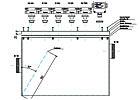Technology at Work: CHEMICAL DETECTION INTEGRATED WITH ACCESS CONTROL

The ion mobility spectrometer (IMS) used by AccuTech Systems Inc., Rockville, Md., from a German company named Dräger works in this way.
In the Washington, D.C., area, home of security and life systems integrator AccuTech Systems Inc., Rockville, Md., businesses can be concerned with a number of security threats that are less familiar to people located farther from the U.S. Capitol. One specialty the systems integrator offers its customers is expertise in intake air quality.
Chemical warfare poses one such danger. Keeping itself ahead of this threat, AccuTech provides customers with traditional security solutions, such as access control, combined with chemical detection technology.

The lid on top of the IMS is detachable. Air enters on the right and exits on the left after passing the baffle, which is at an angle.
“This integration also facilitates the automatic door release and containment requirements that are necessary during an emergency,†he adds.
The heart of the system is an ion mobility spectrometer (IMS), which is approximately the size of a digital video recorder (DVR). It uses sampling tubes similar to those in a duct smoke detector. They are inserted into the flow of air from the fresh air intake that buildings have connected to their heating, ventilating and air conditioning (HVAC) systems.
Each IMS unit is monitored by software that also controls other aspects of security, such as access control. “The IMS is set up in the HVAC system’s air intake locations,†Miller explains. “It samples and tests the air against those chemical compounds it is programmed to look for.â€
For this type of application, the IMS is programmed to search for chemicals such as mustard and nerve gas, ammonia, chlorine, methyl bromide, hydrogen cyanide and other chemical warfare agents.

This is the front of the ion mobility spectrometer IMS 5100 from Dräger.
“When a specified chemical is detected, the IMS identifies the agent, its concentration, and reports the alarm condition,†Miller relates. “Since the IMS is integrated with the HVAC system, the system immediately shuts down, the security management team is notified and therefore enabled to take appropriate action, including building evacuation as necessary.
“Because there are limited areas where fresh air comes in, we can sample all the fresh air intakes,†Miller explains. “This effectively determines the location of the chemical at the exterior source. I’ve found clients have recently put a lot more emphasis on where the fresh air intakes are placed on new facilities. There’s much more security being set up around existing air intakes, as well.â€
Air intakes frequently are located on the roofs or sides of buildings. “They should have fencing or grating to keep individuals from getting directly in front of where the intake occurs,†Miller points out. They may have video, perimeter detection or other electronic sensing devices for added protection.
“You’ll see that on building infrastructure in general, where the roof of a building used to be of little concern, now in government space, it will be a critically monitored area,†he observes.

The ion mobility spectrometer (IMS) is located at this point in the air intake system.
RISK ASSESSMENT
Accutech provides its clients with risk assessments when it is bidding on security installations.“Our role is to assess the client’s needs and then to determine the best product lines to protect their infrastructures and meet their security requirements,†Miller notes. “Our initial risk assessment tells us whether or not clients perceive their facilities to be at risk to this type of attack.â€
Miller’s company has done two major installations that included chemical detection technology. The first was approximately two years ago. Both were government jobs for agencies that must remain unnamed, he says. “In this case, there was a concern about the air intake, and we selected the product that best met their requirements,†Miller explains.
“This is definitely a growing concern,†he notes. “We have a client who has expressed concern about biological attacks, as well. We have yet to install that type of equipment, but we may offer it in the future.â€
Searching for biological agents, such as anthrax, requires different equipment than is used in the chemical detection process. “When a volatile biological substance is detected, that technology captures a sample in a sealed vial and the alert and notification process occurs,†Miller relates.
“In order for biological detection to be effective, a lab specializing in biological diagnostics needs to be in close proximity,†he continues. “The labs are immediately alerted, and they dispatch a team to determine what that compound was, because the detection unit doesn’t have the ability to assess what it was, but only to extract some type of organism that is foreign to the air.â€
Other applications for chemical detection include ones in laboratories, manufacturing and petrochemical plants, and storage facilities, where levels of chemicals used on-site need to be monitored, Miller lists. The IMS can be used to detect leaks or other chemical hazards.
“Chemical and biological detection is an application that is different from a standard camera or burglar alarm system,†Miller points out. “This type of system is meant for clients in need of a comprehensive and aggressive security solution. This is not an inexpensive system, or one that we would propose to just anyone.â€
Sidebar: On the Job
- Dräger 5100 Ion Mobility Spectrometer (IMS)
www.draeger.com - Access 202 software from MAXxess Systems Inc., Anaheim, Calif.
www.maxxess-systems.com

Molecules enter the inlet system of the IMS 5100’s inner cell together with the pumped air.
Sidebar: How an Ion Mobility Spectrometer Works
The ion mobility spectrometer (IMS) used by AccuTech Systems Inc., Rockville, Md., is the IMS 5100 from a German company named Dräger, which has been integrated with Access 202 software from MAXxess Systems Inc., Anaheim, Calif. The IMS uses a small amount of radioactive tritium to analyze intake air.“So basically what happens is as the air enters what they call the drift cell, the radiation source excites the ions,†explains Wes Appleby, MAXxess’ president and CEO. “As they drift through the cell, the IMS identifies the pattern and the drift speed and analyzes that against known samples.â€
The IMS can detect up to 1,000 different chemicals and live agents, but each one is programmed to look for only 16 chemical agents to speed up the analysis so it can respond in as little as five seconds, Appleby notes.
Other companies make ion mobility spectrometers – some are even handheld -- but MAXxess has a relationship with Dräger, markets their units and has integrated them with the MAXxess software, Appleby reports.
“When a chemical agent is detected, the IMS just pulls a very small sample of the incoming air,†Appleby relates. “The software sees the detection and can create a number of actions within the building’s HVAC system as well as sound alerts and send e-mails.
“The first thing that happens is the HVAC system is completely shut down,†he relates. “Depending on the building’s location and emergency plan, they could start exhausting the air back to the outside or possibly contain that volume of air or send it to a particular area. A lot depends on how the HVAC system is designed to handle an exposure, and that depends a lot on the location.â€
Airport and port authorities, corporations, educational institutions, public utilities, manufacturers and government/military facilities are among the users of MAXxess systems. The company provides solutions to detect toxic chemicals, biological, radiological and nuclear (CBRN) threats for companies, large complexes and entire cities.
Links
Looking for a reprint of this article?
From high-res PDFs to custom plaques, order your copy today!


